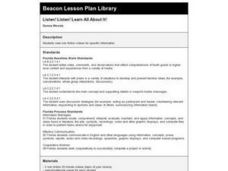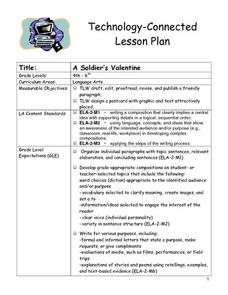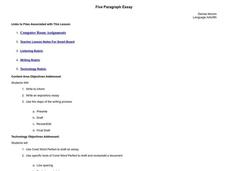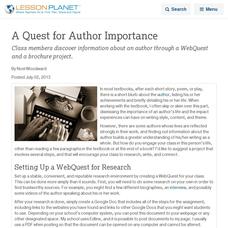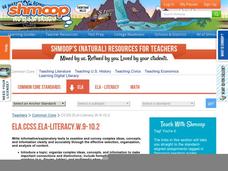Curated OER
Listen! Listen! Learn All About It!
Fourth graders view non-fiction videos. They write questions that can be answered with information in the video. Every 10 minutes the video is stopped and the class discusses the questions.
Curated OER
A Soldier's Valentine
Students create Valentine's for soldiers in Iraq. They review how to write a friendly paragraph and discuss the military and duties of soldiers in Iraq. They create postcards and write reasons why they are rpoud of the military and how...
Curated OER
Five Paragraph Essay
Eighth graders are introduced to the mechanics of writing a standard-form essay. They draft, edit and polish a five-paragraph essay about spending the day as an animal of their choice.
Curated OER
Mastering the Mighty Melville
“Bartleby the Scrivner” as an existential forerunner to The Office? Dense and often dark, Herman Melville’s stories abound with Biblical allusions and complex symbols. If you are considering using Melville’s novels or short stories with...
Curated OER
Creating Historians: Giving Scholars the Answers
How allowing index cards on tests can empower critical thinking; part one of a series on approaching social studies as a group of historians.
Curated OER
A Quest for Author Importance
Class members discover information about an author through a WebQuest and a brochure project.
Curated OER
Reel in Learning with Reptiles
Whether it’s all about a Jackson Chameleon or a North American Bearded Lizard, learners will be eager to embark on informational text with reptiles.
Santa Barbara City College
Structure of a General Expository Essay
A great student reference tool and graphic organizer in one worksheet! Young writers can read a detailed description of each section of a standard five-paragraph essay before completing a graphic organized with their own writing. The...
Curated OER
Cross-Curricular Language Arts Lessons
Here are lesson ideas to begin integrating social studies content into the language arts classroom.
Houghton Mifflin Harcourt
Songwriting Skill - Elaboration: Jesse McCartney - “How Do You Sleep?”
The practice of developing lyrics by elaborating with sensory details and examples continues in the third lesson on songwriting. This time class members examine Jesse McCartney's "How Do You Sleep?" Using procedures established in the...
Curated OER
Left-to-Right Reading
Left-to-right, left-to-right, that's the way we read and write! Watch this short video clip and teach your young learners this chant before they start writing!
Curated OER
Character Impressions
Whether you are planning a unit on F. Scott Fitzgerald's The Great Gatsby, or simply want to improve your pupils' descriptive writing, this lesson could be a good addition to your class. Using the Six-Trait Writing process, pupils...
Curated OER
Who Invented English Anyway?
In these English lesson plans, students use video, the Internet and non-fiction essays to research the history of the English language. They write a short research paper and design a PowerPoint presentation showcasing their findings.
Curated OER
Like It Or Not?
Write a review of the film adaptation of Holes. After viewing the film, your young reviewers make recommendations about viewing the film. Using details to support their opinions, they highlight the important parts of the movie without...
Shmoop
ELA.CCSS.ELA-Literacy.W.9-10.2
The details in the new Common Core standard for producing informative/explanatory texts is different from what you have in your current curriculum, and now you are confused on what to do. Keep calm and carry on, because not only does...
Curated OER
Moore vs. Livingston:Who Really Wrote 'The Night Before Christmas'
Students research an author and gather information that seems to support that person as author of The Night Before Christmas. They work in groups to gather the most solid evidence and they write a persuasive essay presenting their argument.
Curated OER
Analysis Of Theme In The Scarlet Letter
Eleventh graders engage in the reading of the novel "The Scarlet Letter" while choosing a topic to write a literature response. They search the novel for textual evidence to include in writing a paper that supports a well thought...
New York City Department of Education
Grade 3 Literacy: Investigating Sharks
Shark! Scholars read about sharks in Facts about Sharks by Susanna Batchelor. They then pretend they are shark scientists and choose a shark they want to study. Learners research their sharks and record information in graphic organizers...
EngageNY
Presenting a Research-Based Claim: Effective Speaking Techniques
Take note. Scholars receive their claim drafts back to revise and write their claims and three pieces of evidence on notecards. They save the notecards to use when the verbally present their claims to the class. At the end, individuals...
Curated OER
Post-Colonial Writers Unit
How do cultural and historical background impact thought? To explore this essential question, class members view of portion of the film, The Passage to India, read an excerpt from The Magician’s Nephew, and Nissim Ezekiel’s...
Federal Reserve Bank
Arts and Economics Infographic Questionnaire
How do careers in the arts contribute to America's gross domestic product? Use an informative infographic that details the economic details of careers in the core arts, including design services, performing arts, and arts education, to...
Curated OER
Express Yourself Lesson Seed 14: Dedication
Connect Martin Luther King Jr's famous speech, "I Have a Dream," to The Cay by Theodore Taylor. Taylor refers to the speech in his dedication, which creates a natural segue into talking about the speech and how it relates to the novel....
Curated OER
Unit 1: Water is Life: The Heart and Science Behind this Phrase
Water, water, everywhere — but will there be enough to drink? Check out these detailed lesson plans to meet NGSS water cycle and CCSS literacy standards in your science classroom. Learners do a close reading of a challenging, poetic text...
Curated OER
Determining Importance
Students hone their skills at identifying the principle story in a work of art and text. Through discussion, students assess the central and supporting stories of a work of art that is characterized by multiple layers of action and meaning.


